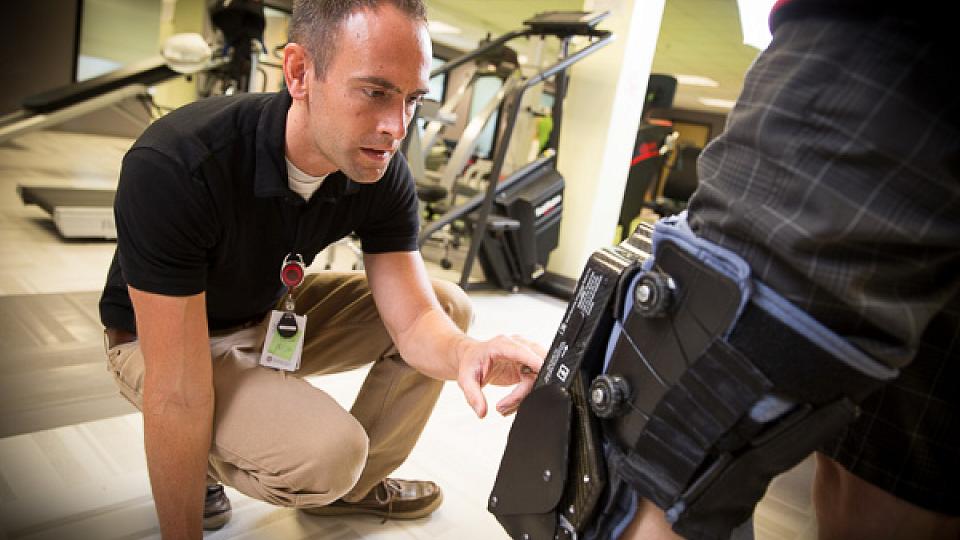
Rehabilitation and Quality of Life Are Key to Stroke Recovery
About 25% of Americans will experience a stroke, according to Steven Edgley, MD, director of stroke rehabilitation at University of Utah Health since 2006. Edgley knows full well how life-changing a stroke can be for both patients and their families. A marathon runner and triathlete, he experienced an unexpected, major stroke at age 28 as a young husband, father, and resident in medical school.
Although most strokes occur in individuals older than 55, the Centers for Disease Control and Prevention estimate that one in seven strokes occur in adolescents and young adults ages 15-49.
Understanding a Stroke
A stroke is a medical emergency that occurs when there is a sudden interruption of blood flow to the brain. There are two types of strokes:
- Ischemic accounts for about 80% of strokes and occurs when the supply of blood to brain is interrupted or cut off by a blood clot (most common).
- Hemorrhagic happens when an artery or blood vessel in the brain ruptures and blood rushes into the brain. It increases intracranial pressure and damages the brain tissue.
Edgley compares the types of strokes to plumbing clogs and leaks—but in this case the plumbing is inside the brain. When a stroke is caused by a clot, it clogs the area, starving the brain of blood; when caused by a blood vessel bursting, the leaks flood the brain with blood so it can’t function.
Treatment for Stroke Patients
The effects of a stroke are varied depending on which part of the brain is affected. Each patient’s cognitive, sensory and motor functions will be affected differently. Some may experience partial paralysis, while others may have spasticity, which means rigid or stiff muscles. Still others may experience neuropathic pain, sensory problems, or a combination of effects. That’s why each stroke patient’s course of treatment is highly individualized.
After 22 years, Edgley says that he has not fully recovered from the stroke even though he did go on to complete medical residency specialty training and continue athletic pursuits. He speaks more slowly than before, and his right arm is partially paralyzed.
“The most important thing is guided therapy, thought rehabilitation, and hard work,” he says. But he advises that neuro-rehabilitation is complex, and patients should always follow the medical standard of care while navigating away from unproved treatments and therapies. Specifically, cognitive retraining is a complicated process and should be guided by an experienced provider, while patients should avoid online sites that provide advice for therapies.
Numerous recent online articles suggested that a “one size fits all” approach to brain exercises and games will help stroke patients recover. “While Sudoku or board games might be good for certain patients, each case is very different,” Edgley says.
Inpatient rehabilitation is ideal with a team of skilled professionals that might include a neuro-rehab physician, a neurologist or internist and other specialty doctors, a psychologist, rehabilitation specialists, physical therapists, a speech and language therapist, a social worker, and a case manager.
Edgley reports that more intense therapy and rehabilitation is best, but the patient must be able to tolerate being pushed to perform at higher levels. Only about a third of stroke patients undergo this type of aggressive rehabilitation. Some patients may not be able to tolerate being pushed to their limit, especially soon after the stroke. Others may have milder effects and symptoms and can participate in outpatient rehabilitation. Still others are patients that cannot participate actively because of frailty, age, stroke severity or other health challenges. These patients may be referred to a skilled nursing facility that will provide a lower level of therapy with the goal of getting them home.
Quality of Life Is an Important Goal
“Our main goal in stroke rehab and in medicine in general is to enable the stroke patient and their family with the highest quality of life,” Edgley says. “But many times, the features of quality of life will be very different from before the stroke. Generally, it’s something that can be achieved depending on a patient’s ability to adapt and work hard.”
He also points out that, for individuals who are older, quality of life may be different than for someone who is young. “Quality of life means different things to different people,” he explains.
Edgley also says that rehabilitation and determining an acceptable quality of life includes more than just the patient’s physical or cognitive conditions. “There is a psychological piece, as well, to this process, and that's what I uniquely understand because of my own personal experience,” he says. “We try to foster resiliency and adaptability in all that we do.”
With the possibility that so many of us will be affected by a stroke, Edgley says that we all need to be better prepared and educated about strokes and stroke recovery.
Reliable online resources for caregivers include the National Institutes for Health and the American Stroke Association.
“As caregivers for a stroke patient, we need to help patients define what quality of life means to them and to care for them in a caring, compassionate way,” Edgley says.





